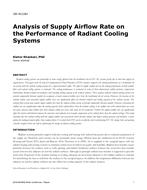Description
Radiant cooling systems can potentially be more energy efficient than the traditional all air HVAC systems partly due to their low supply air requirements. This paper with the help of Computational Fluid Dynamics (CFD) analysis compares the cooling performance of a traditional all air system with the radiant cooling systems for a typical perimeter office. The effect of supply airflow rate on the cooling performance of both radiant floor and radiant ceiling systems is evaluated. The cooling performance is evaluated in terms of three-dimensional airflow patterns, temperature distribution, thermal comfort of occupants, and resulting cooling capacity of the radiant surfaces. These analyses indicate radiant cooling systems can provide comparable thermal comfort for occupants at much reduced airflow rates than the traditional all air system. However, the location of the radiant surface and associated supply airflow rates can significantly affect the thermal comfort and cooling capacity of the radiant systems. The radiant floor system may require higher airflow rate than the radiant ceiling system to provide comparable thermal comfort. However, increasing the airflow rate can significantly reduce the cooling capacity of the radiant floors than the radiant ceilings. Low airflow rates with radiant floor can create hot zones whereas high airflow rates with radiant ceiling can create cold zones for the occupants. Further the supply airflow rate can significantly affect the relative distribution between the convective and radiative heat transfer components of the radiant floors than the radiant ceilings. This study concludes that the radiant ceiling with low supply airflow rate can provide better thermal comfort and higher cooling capacity, and therefore, a better option for cooling perimeter offices than radiant floors. It is noted that CFD can be an effective tool in minimizing HVAC design risks and gaining valuable insights which can help in optimizing the design of radiant cooling systems.
Citation: 2016 Winter Conference, Orlando, FL, Conference Papers
Product Details
- Published:
- 2016
- Number of Pages:
- 8
- Units of Measure:
- Dual
- File Size:
- 1 file , 1.4 MB
- Product Code(s):
- D-OR-16-C061




